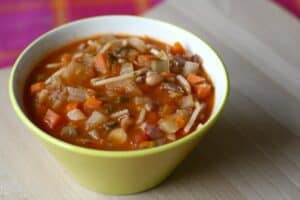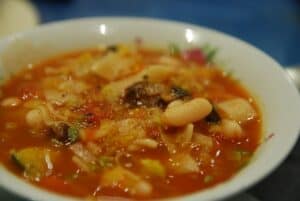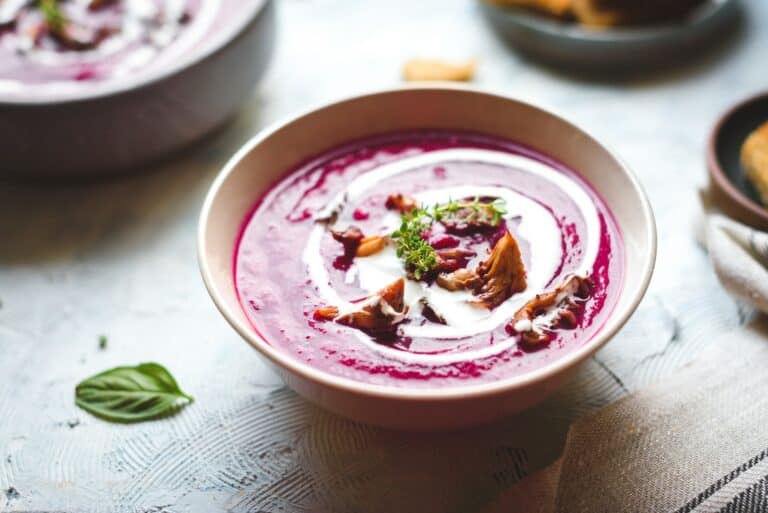Have you ever wondered what is minestrone? Minestrone soup is a classic Italian vegetable soup that is both hearty and delicious. It’s a staple in Italian cuisine, known for its rich flavors and versatility. This soup can be customized to suit your personal taste and dietary needs, making it a favorite amongst vegetarians, vegans, and those who simply love a good bowl of soup. In this blog post, we will explore the history of minestrone, its key ingredients, and variations, as well as providing a delicious recipe for you to try at home.
I. History of Minestrone
Minestrone soup dates back to ancient Rome, where it was a popular dish among Italian peasants. It was originally made from whatever vegetables were in season and available, making it an affordable and nutritious meal option. Over time, the dish has evolved and now includes a variety of vegetables, beans, and pasta, with each region in Italy having its unique spin on the classic minestrone soup.
II. Key Ingredients

At its core, minestrone soup is a thick vegetable soup that is loaded with a variety of vegetables, beans, and pasta. Some of the essential ingredients include:
A. Base ingredients – onions, celery, carrots, and garlic, which are sautéed in olive oil to create a flavorful base for the soup.
B. Vegetables – zucchini, yellow squash, green beans, and tomatoes are commonly used, but you can also include other vegetables like bell peppers, spinach, or kale.
C. Legumes – cannellini beans, kidney beans, and navy beans are popular choices, but you can also use chickpeas or other white beans.
D. Pasta – small pasta shapes like ditalini, orzo, or elbow macaroni work best, but you can also use gluten-free pasta if necessary.
E. Broth – vegetable broth, chicken stock, or chicken broth can be used, depending on your preference and dietary needs.
F. Seasonings – fresh basil, fresh thyme, bay leaf, and red pepper flakes are commonly used to enhance the flavor of the soup.
G. Optional ingredients – parmesan cheese, parmesan rind, and fresh parsley can be added for extra flavor and texture.
III. How to Make Minestrone
Making minestrone soup is a simple process that involves sautéing the base ingredients, adding the broth and seasonings, and then cooking the vegetables, beans, and pasta. Here is a step-by-step guide to making a delicious minestrone soup:
1. Preparing the vegetables: Start by washing and chopping all the vegetables, including the onion, celery, carrots, zucchini, yellow squash, green beans, and tomatoes.
2. Sautéing the base ingredients: In a large pot, heat some olive oil over medium heat. Add the onions, celery, carrots, and garlic and cook until softened, stirring occasionally.
3. Adding the broth and seasonings: Pour in the vegetable broth or chicken stock, along with the canned diced tomatoes, tomato paste, and seasonings such as fresh basil, fresh thyme, bay leaf, and red pepper flakes. Bring the mixture to a boil, then reduce the heat and let it simmer.
4. Cooking the vegetables, legumes, and pasta: Add the zucchini, yellow squash, green beans, and canned beans to the pot. Cook the pasta separately, following the package instructions, until al dente. Drain the cooked pasta and set aside.
5. Adjusting the seasonings: Taste the soup and adjust the seasonings as needed, adding salt, black pepper, or more herbs and spices to your liking.
IV. Tips for Making the Perfect Minestrone

To ensure that your minestrone soup is as flavorful and satisfying as possible, keep these tips in mind:
1. Use fresh, seasonal ingredients: The best minestrone recipes start with fresh, high-quality ingredients. Choose vegetables that are in season for the most vibrant flavors and nutrients.
2. Cook the pasta separately: Cooking the pasta separately helps to prevent overcooking and ensures that the pasta remains al dente. Add the cooked pasta to the soup just before serving.
3. Add a splash of vinegar or lemon juice: Adding a bit of acidity, like a splash of red wine vinegar or lemon juice, can help to brighten the flavors of the soup and add a subtle tanginess.
V. Variations of Minestrone
Minestrone soup can be easily customized to suit your tastes and dietary needs. Here are some popular variations:
A. Vegetarian minestrone soup: Use vegetable broth instead of chicken stock and skip any meat-based ingredients like pancetta.
B. Gluten-free minestrone: Use gluten-free pasta and ensure that all other ingredients, like canned beans and canned diced tomatoes, are gluten-free as well.
C. Minestrone with meat: Add cooked ground beef, sausage, or diced chicken to the soup for a heartier, protein-packed meal.
VI. Serving and Storing Minestrone
Minestrone soup can be served as a starter or a main course, often accompanied by a slice of crusty bread, a salad, or another light side dish. To serve, ladle the soup into bowls and top with grated parmesan cheese and fresh herbs like parsley or basil.
To store leftover minestrone, transfer the soup to an airtight container and refrigerate for up to 4-5 days. If you have already added the pasta to the soup, it may become soft and mushy as it sits in the broth, so it’s best to store the soup and pasta separately if possible.
To reheat leftover minestrone, place the soup in a pot and heat over medium heat, stirring occasionally, until warmed through. If the pasta was stored separately, add it to the soup just before serving to maintain its texture.
VII. Final Thoughts: What is Minestrone?
Minestrone soup is a delicious and versatile dish that can be easily adapted to suit your personal preferences and dietary needs. With its rich flavors and hearty ingredients like vegetables, beans, and pasta, it’s no wonder that minestrone is a beloved classic in Italian cuisine. Give our minestrone soup recipe a try, and you’ll soon discover why this thick vegetable soup has become one of your favorite soups to enjoy all year round.
Other suggested articles:
- What Are Fermented Foods
- What Are Healthy Living Habits
- What Are The Benefits Of Eating Raw Vegetables
- What Are The Benefits Of High Fiber Vegetables
- What Are The Ingredients In Green Tea
- What Do Green Vegetables Do For Your Body
- What Does Green Tea Taste Like
- What Is A Gazpacho
- What Is Black Sapote
- What Is Healthy Living Index
- What Is Hot And Sour Soup
- What Is Minestrone
- What Is Sugar In Food
- What Should Lunch Consist Of
- What Vegetables Help You Sleep At Night
- Vegetarian Soup With Tofu
- Vegetarian Thanksgiving

